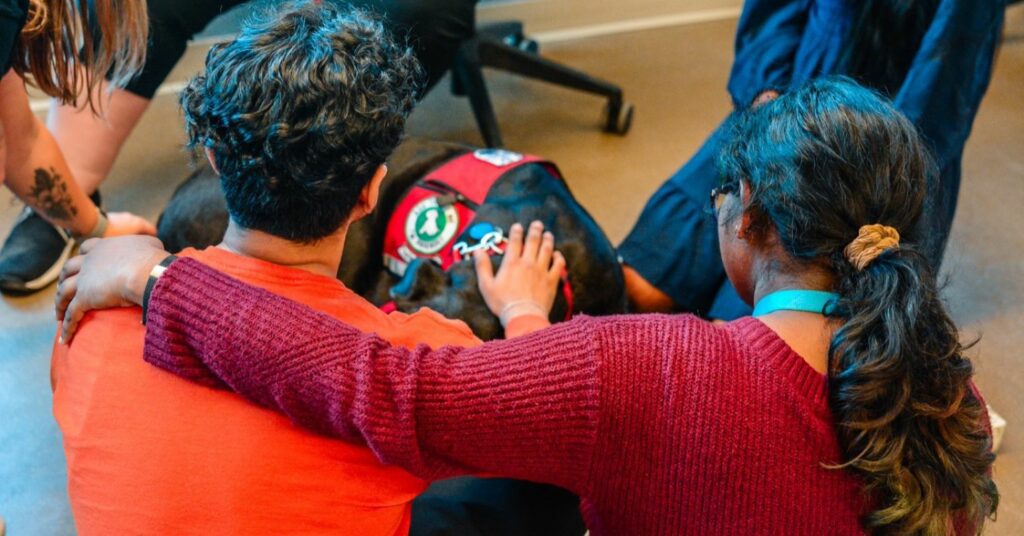College students can build a social and emotional bank to ward off loneliness.
There is little doubt that first-year students attending college and living away from home for the first time are faced with a host of challenges as they adapt to new social and academic demands. Attending college, especially for first-year students, has been described as a potentially stressful and lonely experience. Loneliness is defined as “. . . the subjective and distressing feelings stemming from a discrepancy between one’s desired and actual social connection.” (Holt-Lundstad & Petissinotto (2023, p. 193)). It’s the lone wolf on campus surrounded by a pack but unsure how to join.
article continues after advertisement
Perhaps loneliness on campus is because of the abundance of earbuds and headphones that serve as a protective barrier to interacting with others, curbing conversations. Or, perhaps it’s the competitive ethos found on college campuses that pits students against one another as they vie for grades, coveted reference letters from professors, on-campus jobs, and scholarships? Whatever the reason, students can find being a college student a lonely experience. It’s paradoxical that in a densely populated environment where line-ups abound, students report finding it difficult to establish interpersonal connections with other students – this, despite the ample opportunities to build new social networks and social capital.
Lonely Students Are At-Risk
Not having a social network puts students at increased risk. Researchers have linked elevated rates of loneliness to a number of problematic outcomes, including but not limited to: increased anxiety, depression, and stress, difficulties sleeping, and compromised cognition. Collectively, these outcomes can position students to experience poor mental health and underperform academically.
Students Are Encouraged to Cultivate a Social and Emotional Bank
In addition to moving away from home and having to adapt to communal living (for those students in dormitories), being a first-year student comes with heightened social expectations (in addition to a myriad of academic expectations). Socially, first-year students must establish social networks and find “their people.” Colleges typically offer a series of “community-building activities” that aim to do just that – to glue students together to help them build and establish micro-communities of support. A sort of social and emotional bank, if you will, that students can make deposits into and withdraw from as needed. This micro-community of support is especially important, as researchers investigating help-seeking in college students have found that college students are reluctant help-seekers – they tend to underutilize the on-campus resources available to them, often preferring to handle things on their own or to ask their peers for advice. If students are turning to their peers when faced with problems or challenges, what are students to do if they struggle in making friends and building community? To whom, then, are they to turn?
article continues after advertisement
Taking Advantage of Well-Being Resources Offered on Campus
Students connect on campus in a therapy dog stress-reduction program at the University of British Columbia
Source: Freya L. L. Green Photography; used with permission
In response to the need to create community, colleges strive to offer well-being resources that are low-cost, low-barrier, and characterized by low-stigmatization. This certainly drives our drop-in canine therapy stress-reduction program at the University of British Columbia. We recognize that students don’t want to sign-up for appointments and want few barriers as they make use of well-being resources on campus. Our drop-in program in B.A.R.K. reflects this and students are allowed to stay for as long as they like. Now in its 13th year on campus, we typically see 4,000 students make use of the drop-in each year.
Spending time with therapy dogs might not be every student’s thing, but there are ample clubs, associations, groups, and planned activities where building community, cultivating a social and emotional bank or repository is possible, and where students can find like-minded others. As students cast their mind to starting college this fall, this old professor recommends trekking across campus without one’s protective armour, leaving headphones or earbuds in the dorm room, and being open to the connections that await.
References
Diehl, K.; Jansen, C.; Ishchanova, K.; Hilger-Kolb, J. (2018). Loneliness at universities: Determinants of emotional and social loneliness among students. International Journal of Environmental Research and Public Health, 15(9), 1865. https://doi.org/10.3390/ijerph15091865
Ebert, D. D., Mortier, P., Kaehlke, F., Bruffaerts, R., Baumeister, H., Auerbach, R. P., . . . WHO WMH-ICS Collaborators (2019). Barriers of mental health treatment utilization among first year college students: First cross-national results from the WHO World Mental Health Initiative. International Journal of Methods in Psychiatric Research, 28(2), e1882. https://doi.org/10.1002/mpr.1782
Holt-Lunstad, J., & Perissinotto, C. (2023). Social isolation and loneliness as medical issues. The New England Journal of Medicine, 338(3), 193-195. https://doi.org/10.1056/NEJMp2208029
Krendl, A. (2023). Changes in stress predict worse mental health outcomes for college students than does loneliness; Evidence from the COVID-19 pandemic. Journal of American College Health, 71(1). https://doi.org/10.1080.0744841.2021.1887198
Kurina, L. M., Knutson, K. L., Hawkley, L. C., Cacioppo, J. T., Lauderdale, D. S., & Ober, C. (2011). Loneliness is associated with sleep fragmentation in a communal society. Sleep, 34(11), 1519-1526. https://doi.org/10.5665/sleep.1390
Lim, M. H., Eres, R., & Vasan, S. (2020). Understanding loneliness in the twenty-first century: An update on correlates, risk factors, and potential solutions. Social Psychiatry and Psychiatric Epidemiology, 55, 793-810. https://doi.org/10.1007/s00127-020-01889-7
Source link : https://www.psychologytoday.com/za/blog/canines-kids-and-kindness/202407/fighting-campus-loneliness?amp
Author :
Publish date : 2024-07-30 00:43:25
Copyright for syndicated content belongs to the linked Source.
